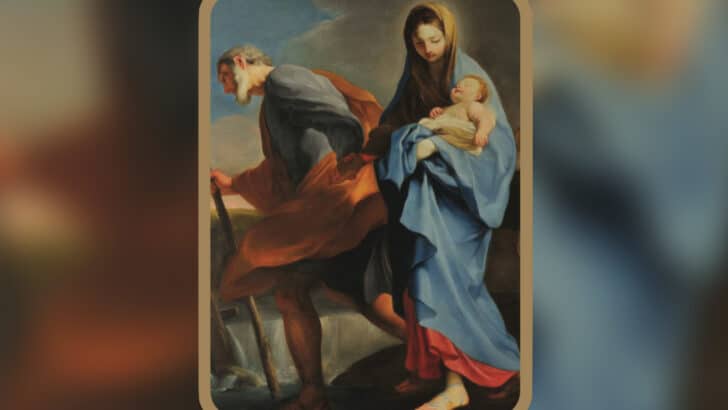I didn’t know what subjects to study when I started at UCG in 1988. I tried out different classes in first year and settled on English and French for the degree. I had a nagging regret through in my second year that I hadn’t taken Gaeilge. But there were other ways to improve at Irish, including attending some of the regular degree classes, which I did.
A particularly interesting lecturer was An Dr Micheál Mac Craith OFM who later became Professor — Ollamh le Nua-Ghaeilge — in the Irish Department. Fr Micheál and I have remained friendly over the years. Which leads me to the Christmas image to the right!
It is from The Flight into Egypt, reproduced here by kind permission of Fr Micheál who is now the Guardian of St Isidore’s College in Rome where I visited last year and where the painting is located.
The Flight into Egypt was one of three paintings executed by Carlo Maratti (1625-1713) at St Isidore’s. St Joseph and Our Lady are depicted holding hands, a feature unusual in the art of the time. The Blessed Virgin’s sandals are surprisingly unsuitable however for a flight by road to a foreign land.
The reason for this may be commercial, Fr Micheál told me during a very informative tour. The straps on Mary’s left sandal come together in the form of a letter ‘A’. Could this refer to the name of the shoemaker? It’s an early example of product placement, if so!
This year will mark the 400th anniversary of the Irish Franciscan presence at the St Isidore’s. Originally a convent established by Spanish Franciscans, it was dedicated to the farmer St Isidore who was canonised in 1622 and later became the patron saint of Madrid.
But the Spanish Franciscans left after running into financial difficulties with the building. The Irish Franciscan, Luke Wadding, undertook to complete it on condition that he could turn it into a project for training young Irish Franciscans.
St Isidore’s became a centre of learning and a reference point in Europe for Irish language, culture and identity during the dark days of the penal laws at home. (The College also became the leading European centre for the study of the theology of Blessed Dun Scotus, which underpinned the doctrine of the Immaculate Conception later declared by the Church.)


 Senator Ronan Mullen
Senator Ronan Mullen
